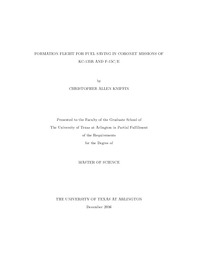
ATTENTION: The works hosted here are being migrated to a new repository that will consolidate resources, improve discoverability, and better show UTA's research impact on the global community. We will update authors as the migration progresses. Please see MavMatrix for more information.
Show simple item record
| dc.contributor.advisor | Dogan, Atilla | |
| dc.creator | Kniffin, Christopher Allen | |
| dc.date.accessioned | 2017-02-14T15:56:35Z | |
| dc.date.available | 2017-02-14T15:56:35Z | |
| dc.date.created | 2016-12 | |
| dc.date.issued | 2016-12-21 | |
| dc.date.submitted | December 2016 | |
| dc.identifier.uri | http://hdl.handle.net/10106/26388 | |
| dc.description.abstract | The fuel saving benefit of formation flight has been demonstrated through theoretical and computational analyses, simulation, wind tunnel and flight tests. When an aircraft flies in a specific region in the wake of another aircraft, it experiences upwash, which results in reduced drag and thus reduced thrust requirement. One specific USAF mission that can potentially benefit from formation flight is coronet missions. In a coronet mission, fighter aircraft are escorted and refueled, as needed, by tanker aircraft over a long range. During the flight, the receiver aircraft fly in formation with the tanker but outside of the wake of the tanker except when they need refueling. In this thesis, the idea of flying the receivers at the sweet spot within the wake of the tanker is investigated. A high fidelity simulation has been developed that models the relative motion of multiple aircraft, aerodynamic coupling between the aircraft, and the effect of mass variation through fuel burn and fuel transfer. Various coronet missions for F-15C and F-15E aircraft escorted by a KC-135R have been simulated. The simulation results are used to quantify the benefit of flying at the sweet spot as compared to outside the wake in terms of the amount of fuel saved. The results show a significant amount of fuel savings for the whole fleet of KC-135R and multiple F-15C or F-15E when the F-15s fly at the sweet spot. The results also showed that the fighter aircraft can fly longer before refueling if it flies at the sweet spot. This implies that the number of refueling maneuvers and number of tanker aircraft involved in a coronet mission can potentially be reduced. The possibility of additional savings is explored by comparing several trimming methods, as well as tracking the sweet spot. The results show that the trimming method only has an insignificant effect on the fuel burn, however, tracking the sweet spot yields significant additional fuel savings. | |
| dc.format.mimetype | application/pdf | |
| dc.language.iso | en_US | |
| dc.subject | Flight control | |
| dc.subject | Formation flight | |
| dc.subject | Simulation | |
| dc.subject | Sweet spot | |
| dc.title | FORMATION FLIGHT FOR FUEL SAVING IN CORONET MISSIONS OF KC-135R AND F-15C/E | |
| dc.type | Thesis | |
| dc.degree.department | Mechanical and Aerospace Engineering | |
| dc.degree.name | Master of Science in Aerospace Engineering | |
| dc.date.updated | 2017-02-14T15:56:35Z | |
| thesis.degree.department | Mechanical and Aerospace Engineering | |
| thesis.degree.grantor | The University of Texas at Arlington | |
| thesis.degree.level | Masters | |
| thesis.degree.name | Master of Science in Aerospace Engineering | |
| dc.type.material | text | |
Files in this item
- Name:
- KNIFFIN-THESIS-2016.pdf
- Size:
- 6.788Mb
- Format:
- PDF
This item appears in the following Collection(s)
Show simple item record


